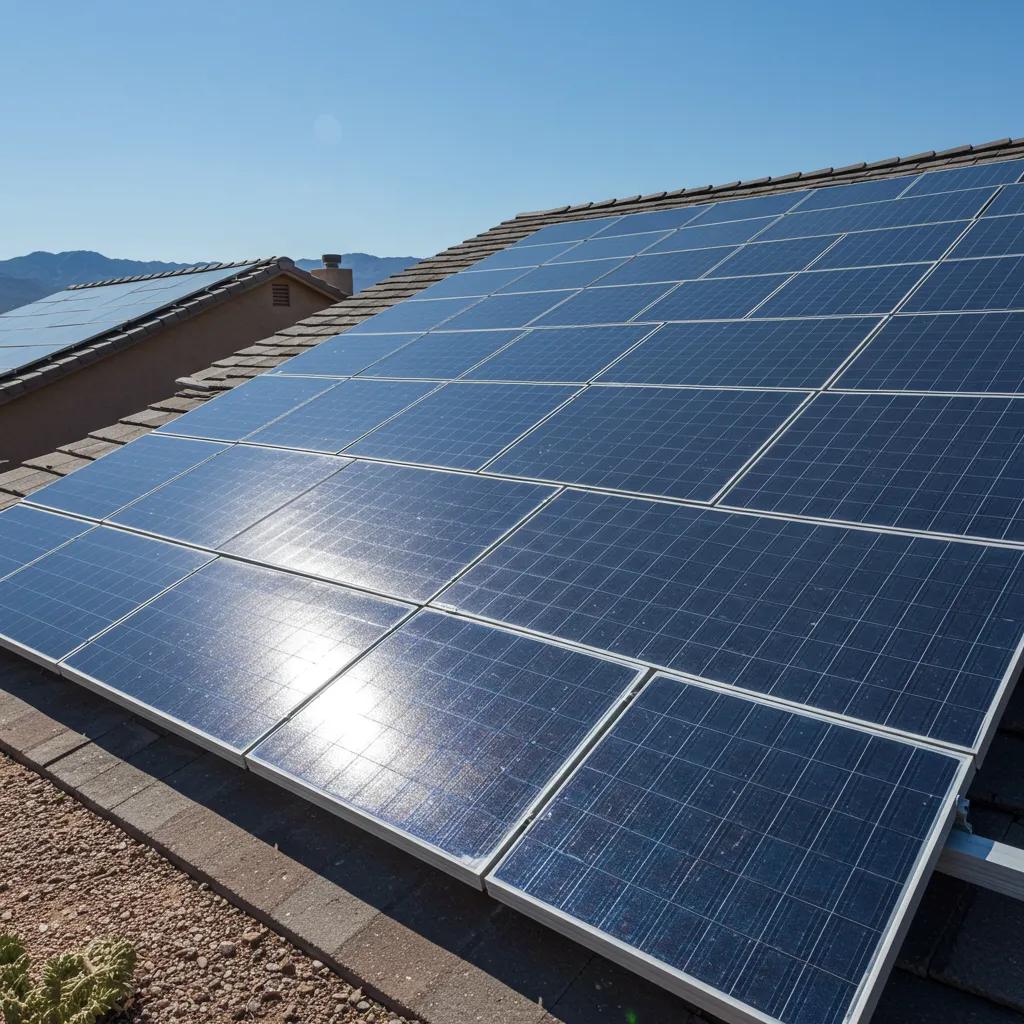Unlock Your Savings: The Federal Solar Tax Credit 2025 & How to Maximize Your ITC Benefits
The federal Solar Energy Investment Tax Credit (ITC) offers a powerful 30% credit against your federal income tax for eligible solar energy systems installed and operational before the close of 2025. This comprehensive guide is designed to help homeowners and businesses harness every bit of this valuable incentive. You’ll discover what makes a system eligible, how to calculate your credit, who qualifies, the simple steps to claim it using IRS Form 5695, and how battery storage and commercial adders can boost your total savings. We understand that navigating documentation, meeting deadlines, and combining federal benefits with local Las Vegas incentives can seem complex. That’s why this article breaks down the regulatory essentials, provides clear checklists and quick-reference tables, and highlights practical strategies specifically for our Las Vegas community. Get ready for step-by-step claiming advice, eligibility insights, comparisons for batteries versus panels, and expert tips on how an experienced installer can simplify your journey.
The Federal Solar Investment Tax Credit: Your Path to Energy Savings
The Solar Energy Investment Tax Credit (ITC) is a powerful federal incentive designed to significantly reduce your tax liability, directly lowering the net cost of your solar energy system. It’s simple: the credit amounts to 30% of your qualifying project expenses for systems that meet eligibility and are placed in service by the specified deadline. This credit is applied directly against the federal income tax you owe, accelerating your payback and boosting lifetime returns. By reducing your initial capital outlay, the ITC ensures your system delivers even greater value as it continues to produce clean energy. Knowing precisely which expenses qualify as the ‘qualified basis’ is key to calculating your exact savings and preparing the necessary documentation for IRS Form 5695.
To help you quickly grasp the essentials, this quick-reference table outlines the main ITC categories, their percentages, valid-through dates, and typical qualified items, allowing you to easily compare eligibility for residential, commercial, and battery storage systems.
This table provides a clear overview of the core ITC components and the typical items that contribute to your qualified basis, offering homeowners and businesses a straightforward framework for estimating their potential credit value. Up next, we’ll dive into the tangible benefits of this 30% credit and show you exactly how it translates into significant dollar savings.
The Power of 30%: How the Solar Tax Credit Benefits Your Home & Business

The 30% ITC delivers immediate and substantial dollar savings by dramatically lowering the effective cost of your solar system. This not only shortens payback periods but also significantly enhances the net present value for both homeowners and businesses. Imagine a typical residential system costing $20,000: applying this credit to the qualified basis could mean a remarkable $6,000 reduction in federal tax liability, boosting your cash flow and accelerating your investment recovery. Beyond these direct tax savings, the ITC paves the way for consistently lower utility bills, a potential increase in your property value, and invaluable protection against future energy price volatility. These compelling financial advantages are perfectly complemented by the environmental and reputational benefits, particularly for businesses committed to showcasing their sustainability leadership.
What Solar Products & Systems Qualify for the ITC?
Generally, qualified items encompass photovoltaic panels, essential racking and mounting hardware, inverters, and the professional installation labor required to bring your system online. Importantly, battery storage systems can also be eligible in many cases, provided they meet specific charging criteria and installation timelines. To claim the full 30% credit, your equipment must be new (not used), and the entire system must be placed in service within the valid period. Costs like permitting and inspection fees are typically included when they are an integral part of the system installation. However, routine maintenance and non-essential add-ons not directly contributing to energy production are usually excluded. Understanding precisely which components qualify is crucial for assembling the correct documentation needed for IRS Form 5695.
Long-Term Impact: ITC, Energy Savings, & Property Value Growth
The ITC significantly reduces the initial capital investment required for a solar system, which in turn dramatically shortens your payback period and boosts your lifetime internal rate of return. Why? Because energy savings begin the moment your system is commissioned. Homes featuring solar arrays consistently demonstrate documented property value improvements, as discerning buyers recognize the immense added value of reduced operating costs and true energy independence. The operational savings generated over a system’s impressive 25- to 30-year lifespan compound the initial tax benefit, delivering a stronger lifetime ROI than nearly any other home improvement. These powerful economic effects converge to make solar installations an exceptionally attractive financial choice for homeowners and commercial property owners alike.
Who Can Claim the 30% Solar Tax Credit in 2025?
Eligibility for the ITC hinges on key factors: system ownership, the ‘placed-in-service’ date, and ensuring your equipment is new and professionally installed. It’s important to note that residential and commercial projects operate under distinct compliance rules. Typically, homeowners who own (not lease) their solar systems and have them operational by December 31, 2025, will qualify for the residential ITC, provided the equipment is new and has not been previously used. Commercial projects, while adhering to similar timing, can also explore ‘adders’ or transferability mechanisms that can significantly alter the effective credit value and compliance requirements. Battery storage systems integrated with solar can also qualify, given they meet specific statutory conditions, usually involving installation after a certain date and being charged by the renewable system as stipulated.
To help you quickly grasp the main differences, here’s a concise checklist comparing residential and commercial eligibility.
- Residential Eligibility Checklist: You must own the system, it must be placed in service by December 31, 2025, the equipment must be new, and the system must serve a qualifying residence.
- Commercial Eligibility Checklist: Project ownership, adherence to placed-in-service timing, potential adders for prevailing wage and apprenticeship compliance, and comprehensive documentation for transferability (if applicable).
- Battery Eligibility Checklist: The battery must be installed and commissioned after the qualifying date, meet specific charging and usage rules, and be included as part of the qualified basis.
Residential Eligibility: What You Need to Know for the Solar Tax Credit
For residential eligibility, it’s crucial that you, the taxpayer, own the solar energy system, and that it is placed in service during the tax year you claim the credit. The ‘placed-in-service’ date is generally defined as when your system is fully ready and available for use. Your residence can be a primary or secondary home, though typically not a rental property unless specific conditions are met. All equipment must be new or satisfy new-equipment criteria. Remember, a contract date does not substitute for the placed-in-service date when claiming the credit, so installations must be fully completed and operational by the deadline. Meticulously tracking commissioning, interconnection, and permission-to-operate dates is absolutely essential to prevent denied claims.
Commercial Solar ITC: Unique Qualifications & Added Incentives
While commercial projects can certainly claim a base ITC, they also have the unique opportunity to qualify for ‘adders.’ These adders, often tied to meeting prevailing wage or apprenticeship requirements, can significantly increase the credit percentage or overall value when compliance is meticulously documented. Furthermore, businesses may explore options to transfer credits or utilize tax-equity structures to monetize credits they cannot immediately use. However, this introduces additional layers of complexity, compliance burdens, and distinct documentation requirements compared to residential claims. Commercial projects frequently demand robust labor and wage records, official certification of compliance, and specific additional filings to secure these adders or execute transfers successfully. These critical distinctions underscore why early planning and expert professional tax advice are invaluable for commercial owners.
Battery Storage: Boosting Your Solar Tax Credit Eligibility?
Absolutely, battery storage systems can indeed qualify for the ITC, provided they are installed and adhere to all statutory eligibility rules, including specific installation timing and any charging or usage conditions. When batteries are seamlessly paired with solar, the costs directly attributable to the battery system typically count towards your qualified basis, assuming the battery is charged by the solar array or fulfills other program requirements. This inclusion significantly increases your total credit dollar amount. Integrating batteries not only expands your upfront savings but also enhances long-term resilience by enabling greater self-consumption and reliable backup power. However, careful tracking of sizing and precise cost allocation between solar and battery components is essential. Comprehensive documentation of battery purchase, installation, and commissioning is paramount to successfully support your claim on Form 5695.
Claiming Your Federal Solar Tax Credit: A Step-by-Step Guide with IRS Form 5695

Claiming your residential ITC is a clear process: simply complete IRS Form 5695 and attach it to your annual federal income tax return. This form is designed to capture your qualified expenses and precisely compute your allowable credit. The basic steps involve totaling all qualifying costs for the tax year, entering these amounts on the specific lines for residential energy credits on Form 5695, and then carrying the calculated credit to your main tax return (Form 1040) to offset your tax liability. Should your tax liability be insufficient to utilize the full credit in a single year, the unused portion can typically be carried forward to subsequent tax years, in accordance with current IRS rules. Meticulous recordkeeping and retaining all invoices, payment proofs, system specifications, and placed-in-service dates are absolutely essential to confidently support your claim in the event of an IRS inquiry.
Before we dive into the checklist, here’s a compact table organizing the crucial documents homeowners should gather *before* filing Form 5695, ensuring you can document your claim efficiently and effectively.
IRS Form 5695: Your Guide to Completing the Residential Energy Credits Form
IRS Form 5695 is your essential Residential Energy Credits form, specifically designed to calculate your residential clean energy credit, including the valuable solar ITC. Homeowners complete this form to precisely determine the credit amount they can transfer to their Form 1040. The form clearly requests your total qualified expenses for the tax year and then computes the credit by applying the relevant percentage to your qualified basis, offering dedicated lines for carryforwards and adjustments should your credit exceed your current tax liability. To complete it, simply enter your total solar costs, any credits previously applied, and any carryforward amounts from prior years, then transfer the allowable credit to your main tax return. If you ever have questions or are unsure, we strongly recommend consulting a qualified tax professional to ensure accurate completion and to confirm all carryforward rules.
Essential Documentation for Your Solar Tax Credit Claim
To confidently support your solar tax credit claim, homeowners must meticulously retain several key documents. These include detailed invoices itemizing labor and equipment costs, comprehensive payment records demonstrating amounts paid, official equipment specification documents, and critical commissioning or ‘permission-to-operate’ dates that definitively establish the ‘placed-in-service’ moment. Other valuable items include installer statements confirming the scope of work, receipts for any permitting fees that are part of qualified costs, and official interconnection approval letters from your utility. Keeping all these documents well-organized in both digital and physical copies will significantly simplify the process of filling out Form 5695 and responding to any potential tax inquiries. Think of properly labeled and stored documentation as your practical insurance policy, safeguarding the valuable tax benefit you’ve earned.
Vegas Solar: Your Partner in Maximizing Your Solar Tax Credit
At Vegas Solar, LLC, we are dedicated to helping Las Vegas homeowners identify every qualifying system component, meticulously assemble all required documentation, and perfectly align installation timelines to meet the crucial ‘placed-in-service’ deadlines for the ITC. Our comprehensive offerings include free online solar consultations where we review your project scope, provide detailed invoices and equipment lists perfectly suited for Form 5695, and expertly advise on the commissioning and interconnection steps that definitively establish your eligibility date. Since timely documentation and precise expense allocation directly impact your credit amount, our installer-provided paperwork and expert scheduling guidance can significantly reduce administrative risk. We invite homeowners across Las Vegas to request a free consultation with Vegas Solar today to assess your eligibility, confirm all documentation needs, and craft an installation timeline that ensures you maximize your federal tax-credit capture.
Act Now: The Critical 2025 Solar Tax Credit Deadline & Its Impact
The residential 30% ITC is set to apply only to systems placed in service through December 31, 2025. Installations commissioned *after* this date may no longer qualify for the full 30% benefit. This is a firm deadline, meaning homeowners and businesses aiming for the maximum 30% credit must strategically plan their installations to ensure construction, commissioning, and interconnection are all completed before year-end. This requires careful consideration of permit and utility lead times. Recent legislative action has accelerated the original timeline, making proactive planning absolutely essential to avoid losing out on substantial tax savings. Delays can lead to increased net project costs, extended payback periods, and a significant erosion of your projected ROI. Therefore, a clear understanding of scheduling and lead-time implications is paramount.
So, when should homeowners schedule their installations to confidently meet this crucial ‘placed-in-service’ deadline? Permit cycles, contractor availability, and utility interconnection windows can vary significantly by region. Therefore, planning at least several months in advance is often imperative, especially in thriving local markets. For households that unfortunately delay past the deadline, the financial impact can be severe: a direct loss of 30% of qualified expenses, which will significantly increase net costs and extend your payback period by multiple years. Given these high stakes, taking decisive action *now*—to obtain quotes, finalize your equipment choices, and reserve your installation window—is the surest way to secure this valuable credit and protect your projected savings.
The Clock is Ticking: Residential Solar Tax Credit Expiration
The residential ITC’s highly valuable 30% credit is specifically for systems that are placed in service by December 31, 2025. After this date, the base credit percentage will change according to statutory provisions. This ‘placed-in-service’ timing is the *operative test* for eligibility, meaning your construction must be fully completed and commissioning must occur within this qualifying window to claim the 30% credit for that tax year. Homeowners must meticulously track commissioning and interconnection dates, as contracts or payments alone do not establish placed-in-service status. Missing this critical date typically results in losing the full 30% credit or being subject to a significantly lower credit percentage if Congress or new rules introduce phased reductions.
The ‘One Big Beautiful Bill’: Accelerating the ITC Deadline
Recent legislative action, as highlighted by policy analysts, has effectively moved the residential ITC expiration date earlier than many stakeholders anticipated. This consolidated the schedule, meaning the full 30% credit will now conclude at the close of 2025. This acceleration has significantly shortened the planning window for countless homeowners and amplified the urgency for installations that might otherwise have qualified under a more gradual phase-down. This pivotal policy change powerfully underscores the critical importance of aligning your project timelines with statutory deadlines and reinforces why early engagement with experienced installers and utilities is absolutely prudent. For anyone planning a solar project, this legislative shift has transformed a future planning decision into an immediate and undeniable scheduling imperative.
Missing the 2025 Deadline: Significant Financial Consequences
Failing to place your solar system in service by the critical deadline can dramatically increase your project’s net cost by the entire lost credit amount—typically 30% of your qualified expenses. This could mean adding thousands, even tens of thousands, of dollars, depending on your system size. This higher net cost will inevitably lengthen payback periods, significantly reduce your internal rates of return, and could even shift projects from being clearly economical to only marginally viable, particularly for smaller residential systems. For businesses, missing this deadline might mean forfeiting valuable adders or being forced into alternative financing structures that further complicate financial planning. Given this substantial fiscal impact, homeowners and businesses must prioritize robust timeline risk management when budgeting and scheduling their solar projects.
Before we explore battery and commercial adders, we strongly recommend securing expert support from a trusted local installer to confidently navigate these crucial deadlines and documentation requirements. Vegas Solar proudly offers free consultations and tailored scheduling advice, specifically designed to help Las Vegas property owners perfectly align their installations with the 2025 deadline and significantly reduce any timing risk.
Unlock More Savings: Battery Storage & Commercial Solar ITC Opportunities
Battery storage systems present a fantastic opportunity to increase your total ITC-eligible costs. This is because battery hardware and installation expenses can often be included in the qualified basis when specific eligibility criteria are met, thereby significantly enlarging the dollar amount of your credit. Commercial projects, in particular, can capture valuable ‘adders’ for complying with prevailing wage and apprenticeship requirements, and they may even be able to transfer or sell credits depending on specific program rules, which can profoundly alter project economics. A thorough evaluation of battery sizing, precise cost allocation, and commercial compliance options empowers owners to accurately quantify these additional savings and determine if the extra investment yields a proportionate increase in tax-credit benefits. A clear comparison across batteries, panels, and commercial projects will illuminate the trade-offs between incremental cost and the added tax credit value.
To help you prioritize your investments effectively, the following comparison table clearly outlines ITC eligibility, potential adders, transferability options, and estimated additional savings across battery storage, residential panels, and commercial projects.
Battery Storage: Supercharging Your Tax Credit Savings
When a battery system meets statutory eligibility—often by being seamlessly installed with or charged by a qualifying solar system—it becomes an integral part of your qualified basis. This means its cost can be fully included in the 30% calculation, thereby yielding substantial additional upfront tax savings. Consider this example: a $10,000 battery eligible for the ITC would generate an impressive additional $3,000 credit at the 30% rate, directly lowering your net project cost and significantly improving your payback period. Beyond these direct savings, batteries deliver powerful operational benefits like enhanced self-consumption, crucial demand-charge mitigation for businesses, and reliable backup power, all of which can indirectly boost your lifecycle savings. Comprehensive documentation that precisely allocates battery costs to the qualifying project is paramount to successfully substantiate this additional credit on Form 5695 or any corresponding commercial filings.
Las Vegas Commercial Solar: Federal Adders & Local Incentives
Commercial projects in Las Vegas have the distinct advantage of pursuing federal adders that significantly increase credit value when projects meticulously comply with prevailing wage and apprenticeship rules. Beyond this, businesses can also explore a range of state or local incentives that seamlessly stack with the federal ITC. Local Nevada and Las Vegas utility programs frequently offer valuable rebates or performance-based incentives designed to reduce net costs. Furthermore, commercial projects may qualify for additional local tax or grant programs, depending on specific jurisdictional rules. Since both federal adders and local programs come with their own set of compliance and documentation requirements, partnering with an experienced local installer or a knowledgeable financial advisor is crucial to ensure full compliance and maximize every stacking opportunity. Businesses should thoroughly evaluate both federal compliance paths and available local incentives to calculate their most accurate after-incentive costs.
Commercial Solar: Understanding Tax Credit Transferability
Tax credit transferability offers a powerful mechanism for certain commercial taxpayers to transfer or sell their federal tax credits to unrelated entities. This enables immediate monetization of credits, providing a significant boost to cash flow, but it also triggers specific reporting and contractual requirements. While transfer mechanisms can dramatically improve cash flow and lessen reliance on traditional tax-equity partners, the process typically involves fees, intricate legal documentation, and careful consideration of trade-offs between immediate effective value and retaining credits for future tax liabilities. Businesses exploring transferability must meticulously weigh the present value of a sale against potential future tax benefits and fully account for the administrative complexity and rigorous compliance checks involved. Expert professional advice and proactive early planning are absolutely essential when considering transferability options.
Maximize Your Impact: Combining Federal & Local Solar Incentives in Las Vegas
Combining the federal ITC with state and local incentives can dramatically reduce your net project cost, provided programs are compatible and meticulously coordinated. This ‘stacking’ strategy demands careful attention to timing, precise eligible expense definitions, and understanding potential interaction rules. Nevada and Las Vegas proudly offer a suite of utility programs and local incentives that can provide valuable rebates, performance payments, or even expedited interconnection pathways. These local benefits perfectly complement the federal 30% credit, working together to significantly lower your effective installed costs. The stacking process typically follows a strategic administrative order: first, estimate your gross costs, then apply any local or utility rebates, and *then* compute the federal ITC on the remaining qualified basis, as permitted by program rules. This accurate coordination ensures homeowners and businesses capture multiple powerful savings streams without ever jeopardizing federal eligibility.
Below, we outline common incentive types and how they powerfully interact with the federal ITC within a strategic stacking context.
- State rebates and utility performance incentives that directly reduce your out-of-pocket costs *before* tax calculations.
- Net metering or time-of-use rate structures that enhance operational value but do not directly alter ITC eligibility.
- Local permitting or inspection fee waivers that reduce project soft costs and significantly improve net economics.
Masterfully coordinating these incentives yields a powerful combined effect, far greater than any single program could offer. Meticulous recordkeeping is essential to ensure each program’s specific conditions are met. Up next, we’ll delve into specific local and state programs that Las Vegas homeowners should absolutely consider when planning their solar installation.
Las Vegas Local & State Solar Incentives: Beyond the Federal ITC
In Las Vegas, a wealth of local incentives awaits, potentially including robust utility rebate programs, advantageous net metering arrangements, and state-level initiatives that provide significant additional cost reductions or performance-based payments. It’s important to remember that availability and terms can evolve over time. Homeowners should actively investigate current Nevada incentives and utility offerings, which might feature upfront rebates for residential arrays, performance-based incentives for energy exports, and even expedited permitting in certain jurisdictions. Given that program rules and availability are subject to change, consulting a trusted local installer or an expert energy advisor who diligently tracks these updates is not just practical—it’s crucial for preventing lost opportunities. Strategic sequencing and meticulous compliance are key to ensuring that state or local incentives do not inadvertently alter your qualified basis for federal ITC calculations.
Maximize Your Savings: The Power of Stacking Federal & Local Incentives
Strategically stacking federal and local incentives is the ultimate way to reduce the net cost paid by the owner and dramatically improve project payback. This is achieved by layering distinct savings mechanisms: the federal ITC significantly lowers your tax liability, while local rebates directly reduce your upfront cash outlay. Let’s consider a simple example: a system with a $20,000 installed cost that first receives a $2,000 local rebate, and *then* qualifies for a 30% ITC. The federal credit would be calculated on the qualified basis as permitted, and by correctly sequencing these reductions, you unlock the maximum legal benefit. Combining incentives also leads to smaller financing needs, which in turn lowers interest costs and further boosts your ROI. Meticulous administrative sequencing and comprehensive documentation are paramount to ensure owners fully realize this powerful cumulative financial advantage.
Vegas Solar: Your Expert Guide to Local Solar Incentives
Vegas Solar, LLC is your trusted partner, empowering Las Vegas homeowners and businesses to confidently identify all applicable local and state incentives, meticulously prepare required paperwork, and seamlessly coordinate with utilities and permitting authorities to significantly accelerate project timelines. Our comprehensive services include thorough incentive vetting, precise eligibility checks, and expert coordination of all documentation needed to claim local rebates while meticulously preserving your federal ITC eligibility. All this begins with a free online solar consultation. Our unparalleled local expertise dramatically simplifies complex stacking decisions and effectively reduces administrative friction for property owners committed to combining incentives for maximum benefit. Scheduling a free consultation with Vegas Solar is the definitive first step to clearly map out all your incentive opportunities and craft an installation timeline that truly maximizes your combined savings.
Your Questions Answered: FAQs About the Solar Tax Credit
What are the risks of missing the 2025 solar tax credit deadline?
Missing the critical December 31, 2025, deadline for placing your solar system in service can lead to substantial financial repercussions. Homeowners risk losing the entire 30% tax credit, which could add thousands of dollars to your overall project cost. This significant increase in net expenses will inevitably extend payback periods and diminish your internal rate of return, making the investment considerably less attractive. For businesses, missing this deadline could mean forfeiting valuable adders or being forced into alternative financing structures that further complicate financial planning.
How can I ensure my solar system meets the placed-in-service deadline?
To confidently meet the ‘placed-in-service’ deadline, homeowners should initiate their solar installation planning well in advance—ideally several months before the deadline. This proactive approach involves obtaining comprehensive quotes, finalizing your equipment choices, and firmly scheduling installation with trusted contractors. It’s absolutely crucial to factor in permit processing times and utility interconnection requirements, as these can vary significantly by region. Maintaining regular, clear communication with your installers and utility providers is key to ensuring all necessary steps are completed on time, thereby securing your eligibility for the full tax credit.
What essential documentation do I need for my solar tax credit claim?
To confidently support your solar tax credit claim, you must meticulously gather specific documentation. This includes detailed invoices itemizing the costs of equipment and installation, clear proof of payment, and precise records of the commissioning date. Furthermore, all equipment specifications and any permits or inspection approvals should be carefully retained. Proper organization of these vital documents is paramount, as they will be indispensable when completing IRS Form 5695 and may be requested during a potential IRS audit. Keeping both digital and physical copies will significantly simplify your claiming process.
Are there state-specific solar incentives for Las Vegas installations?
Absolutely! Las Vegas homeowners have the exciting opportunity to take advantage of various state-specific incentives that perfectly complement the federal ITC. These can include valuable utility rebate programs, performance-based incentives, and even expedited permitting processes. It’s important to note that the availability and terms of these incentives can evolve, so it’s always advisable to consult with trusted local installers or expert energy advisors who are fully up-to-date on current offerings. Masterfully coordinating these local incentives with your federal tax credit can significantly enhance your overall savings on solar installations.
How do commercial solar projects qualify for the tax credit differently?
Commercial solar projects indeed have distinct eligibility criteria for the ITC when compared to residential installations. While they can qualify for the same powerful 30% base credit, they also have the unique opportunity to access additional incentives, known as ‘adders.’ These adders are typically earned for meeting specific compliance requirements, such as prevailing wage or apprenticeship standards. Moreover, commercial projects can strategically explore options for transferring or selling their tax credits, which can provide immediate and substantial cash flow benefits. This added layer of complexity necessitates meticulous planning and expert consultation with tax professionals to truly maximize all available benefits.
What are the benefits of combining federal and local solar incentives?
Combining federal and local solar incentives offers a powerful strategy to significantly reduce the net cost of your solar installation. By strategically stacking these incentives, homeowners can dramatically lower their upfront expenses and substantially improve their overall return on investment. For instance, a local rebate can be applied *before* calculating the federal ITC, thereby maximizing your tax benefits. This intelligent, strategic approach not only enhances your financial savings but also allows for smaller financing needs, which in turn can further reduce interest costs. Meticulous documentation and unwavering compliance are absolutely essential to ensure your eligibility for all available incentives.




